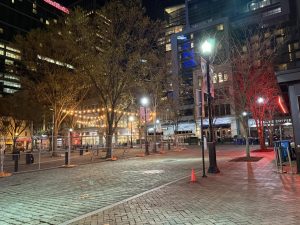JPEGMAFIA and Danny Brown collaboration review: quality beats, underwhelming mixing
March 29, 2023
Experimental hip-hop is a difficult genre to define. Given the constantly evolving nature of the genre, labeling any artist as experimental can age. For example, the Beastie Boys’ album “Paul’s Boutique” is one of the most important examples of experimentation in hip-hop, but by modern standards, it is relatively straightforward.
Rapper Danny Brown’s 2016 album, “Atrocity Exhibition,” is perhaps the best-known and most widely acclaimed experimental hip-hop album of all time (aside from maybe Death Grips’ “The Money Store”). So when JPEGMAFIA, who in recent years has emerged as one of the greatest rapper-producers of all time, announced that he would be releasing a collaboration with Brown, expectations were high.
In terms of songwriting, “Scaring the Hoes Volume One” is one of the most unique projects that JPEG has released in years. The sampling is exquisite and thoughtful and the beats are well-assembled. From a production standpoint, this piece of work is clearly a JPEG project. If you’re familiar with JPEG’s discography, this project is reminiscent of some of his earlier works, such as 2018’s Veteran and 2016’s Black Ben Carson. The beats retain the harshness that those projects are known for, although JPEG incorporates the synth-heavy, lo-fi production he has dabbled with in his more recent releases.
That being said, this project has a completely unique identity. In that regard the album is fantastic. The best thing that an experimental artist can do is experiment. While you can chart the evolution of JPEG’s sound, this project feels incredibly fresh.
JPEG produced the beats for this entirely on a Roland SP-404 MKII, a sampler drum pad. JPEG typically produces his music in ProTools and said he wanted to attempt making a project entirely on one machine.
On one hand, the style in which this was recorded gives it a very idiosyncratic feel. The chopped-up samples and drum loops blend directly together very well, and sonically this album is very impressive. On the other hand, the vocals on this project are poorly mixed at times.
The mix of this album has been the subject of popular debate online. Some argue that criticizing the mix is disingenuous, given the experimental nature of the album. That’s ridiculous. Just because an album is experimental or designed to sound distorted does not excuse legitimate production issues. That isn’t to say that the mix is awful, but it is sub-par to what JPEG has previously produced, especially when compared to 2021’s “LP!”
JPEG even produced a song for Brown’s 2019 album U Know What I’m Saying? The track, 3 Tearz, features Run the Jewels and sounds incredibly clean. Comparing that track to a track off of STHV1, the mixing is night and day. JPEG himself even admitted that the mix on the first single needed to be fixed and re-uploaded the track with alterations.
The mixing is primarily impacting Brown’s vocals — his rapping style is chaotic and somewhat unintelligible, and his vocals are mixed in a way that makes them even more difficult to understand. At times his lyrics are completely overpowered by the beats. This isn’t a universal problem with the album, and it only comes up at certain times, but the problem is definitely there.
That being said, it is better to have an interesting-sounding album with an underwhelming mix than a terrible album mixed very well. If JPEG goes back and cleans up the mix, this project is a contender for the coveted “Album of the Year,” and potentially a greatest of all time, but if not this project is still a strong set of tracks.

















